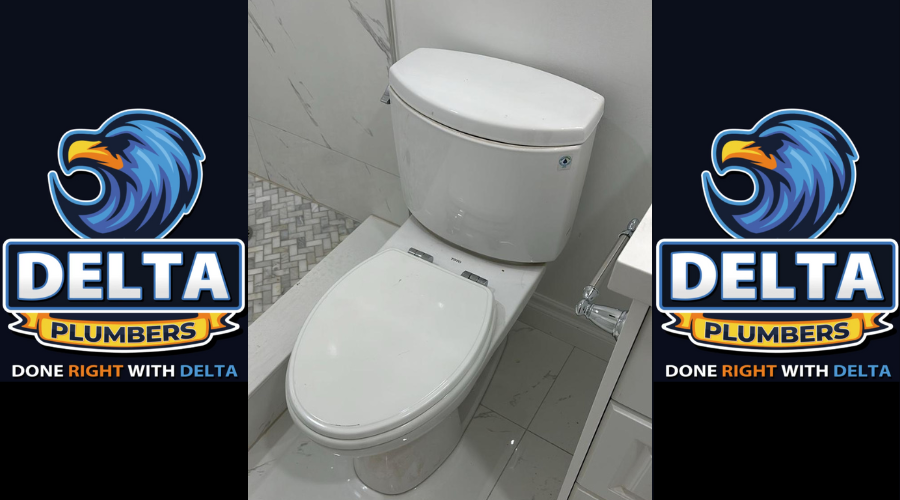Toilet leaks are a common issue in many households, and while some leaks are obvious, others can be much more difficult to detect. Silent toilet leaks, which go unnoticed due to the absence of noise or visible water, can waste thousands of gallons of water annually, leading to higher water bills and potential damage to your home. In this comprehensive guide, we’ll walk about how to detect and fix silent toilet leaks.

Picture Source – Delta Plumbers
How to Detect a Silent Toilet Leak?
Detecting a silent toilet leak can be tricky because, as the name suggests, these leaks do not make any noise, and there are often no visible signs of water on the floor. However, there are several methods you can use to identify whether your toilet is leaking silently.
1. The Food Coloring Test:
One of the simplest and most effective ways to detect a silent toilet leak is by using food coloring. To perform this test:
-
- Remove the lid from your toilet tank.
- Add a few drops of food coloring to the water in the tank.
- Wait for about 15-30 minutes without flushing the toilet.
- After waiting, check the water in the toilet bowl. If the colored water from the tank has seeped into the bowl, you have a silent leak.
2. Water Meter Check:
Another method to detect a silent leak is by using your water meter. This process involves turning off all water fixtures in your home, including faucets, washing machines, and dishwashers.
-
- Once all water usage has ceased, check the water meter reading.
- Wait for about 15 minutes without using any water, then check the meter again.
- If the meter reading has changed, you likely have a leak somewhere in your plumbing system, and the toilet could be the culprit.
2. Check for Phantom Flushes:
Phantom flushes occur when your toilet appears to flush on its own without anyone using it. This phenomenon is typically caused by a silent leak in the toilet tank. If you notice your toilet making flushing sounds intermittently, it’s a clear sign that you should investigate further.
3. Examine the Water Level in the Tank:
The water level in the toilet tank should be consistent. If you notice that the water level drops over time without flushing, it could be due to a silent leak. Mark the water level with a pencil, and check it after a few hours to see if it has dropped.
4. Listen for Hissing Sounds:
While silent leaks may not make noise, some leaks are accompanied by a faint hissing sound. If you hear this sound near your toilet, especially when it’s not in use, it could be a sign of a leak.
Also Read: Signs You Need to Replace Your Plumbing Pipes

Picture Source – Delta Plumbers
Can a Toilet Leak Without Noise?
Yes, a toilet can definitely leak without making any noise. Silent leaks are typically caused by issues within the toilet tank, such as a faulty flapper, a worn-out flush valve, or a misaligned fill valve. These leaks are often undetectable by sound and may not leave any visible signs of water damage, making them particularly insidious.
Silent leaks are problematic because they can waste a significant amount of water over time without your knowledge. Even a small, unnoticed leak can lead to thousands of gallons of wasted water per year, significantly increasing your water bill. The best way to prevent this is by regularly inspecting your toilet and being vigilant for any signs of water waste.
Also Read: How to Unclog Drains Naturally

Picture Source – Delta Plumbers
What is an Easy and Cheap Method for Finding a Leak in the Toilet?
Detecting a leak in your toilet doesn’t have to be expensive or complicated. The food coloring test, mentioned earlier, is one of the easiest and most cost-effective methods for finding a silent leak.
How to Perform the Food Coloring Test:
- Step 1: Get a bottle of food coloring. Any color will do, but blue or red tends to be the most visible.
- Step 2: Lift the lid off your toilet tank.
- Step 3: Add about 10-15 drops of food coloring into the water in the tank.
- Step 4: Wait for at least 15 minutes without flushing the toilet.
- Step 5: Check the water in the toilet bowl. If you see colored water in the bowl, there is a leak.
This method works because if the water in the tank is leaking into the bowl, it will carry the food coloring with it. This test is highly effective and costs less than a dollar, making it accessible to everyone.
Another simple method is to check for condensation on the exterior of the toilet bowl. If the bowl is constantly wet, it might indicate a slow leak inside the toilet, leading to a continuous flow of cold water that causes condensation.
Also Read: Leaky Faucet: How to Prevent and Fix

Picture Source – Delta Plumbers
Where is the Most Common Place for a Toilet to Leak?
Toilets can leak from several different places, but the most common areas where leaks occur include:
1. The Flapper Valve:
The flapper valve, located at the bottom of the toilet tank, controls the flow of water from the tank into the bowl. Over time, the flapper can become worn, warped, or coated with mineral deposits, causing it to fail to seal properly. This allows water to continuously leak from the tank into the bowl, leading to a silent leak.
2. The Flush Valve Assembly:
The flush valve is the mechanism that releases water from the tank into the bowl when you flush. If the flush valve assembly is damaged or misaligned, it can cause a leak. This type of leak is often silent and can be difficult to detect without close inspection.
3. The Fill Valve:
The fill valve controls the flow of water into the toilet tank after a flush. If the fill valve is not adjusted correctly or is malfunctioning, it can cause the water level in the tank to rise too high, leading to a leak through the overflow tube.
4. The Wax Seal:
The wax seal is located between the base of the toilet and the floor. Its purpose is to prevent water from leaking out from the bottom of the toilet. Over time, the wax seal can deteriorate, leading to leaks. These leaks are often noticeable as water pooling around the base of the toilet, but they can also be silent if the water seeps into the subfloor.
5. The Tank Bolts:
The bolts that secure the toilet tank to the bowl can sometimes loosen or corrode, leading to leaks. Water can escape from the connection between the tank and the bowl, especially if the bolts are not properly tightened or the washers have worn out.
Identifying the exact location of the leak is crucial for effective repair. Each of these common leak points requires a different approach to fix, so understanding where the problem lies will help you address it more efficiently.
Also Read: Regular Plumbing Maintenance: Why It Is Important

Picture Source – Delta Plumbers
Why Does My Toilet Make a Dripping Sound but No Leak?
If your toilet makes a dripping sound but you can’t find any visible leak, it’s possible that the sound is coming from within the toilet tank itself. Several potential issues could be causing this dripping sound:
1. Water Level Too High:
If the water level in the tank is set too high, it can cause water to spill into the overflow tube, leading to a continuous dripping sound. This is not technically a leak in the traditional sense but can still waste water.
2. Slow Leak from the Flapper:
A slow leak from the flapper can cause a dripping sound as water slowly escapes from the tank into the bowl. This might not produce an obvious leak, but the sound can be audible, especially in a quiet environment.
3. Condensation:
Sometimes, condensation can form on the outside of the toilet tank due to differences in temperature between the cold water in the tank and the warm air in the bathroom. As the condensation drips off the tank, it can create a dripping sound. This is more common in humid climates or during warmer months.
4. Fill Valve Issues:
A malfunctioning fill valve can cause water to trickle slowly into the tank even after it’s full, creating a dripping or hissing sound. This issue is often silent, but it can still waste water over time.
If your toilet is making a dripping sound and you can’t identify a visible leak, it’s essential to investigate further. Start by checking the water level in the tank and adjusting the fill valve if necessary. You can also perform the food coloring test to check for a slow leak from the flapper. If the problem persists, it might be time to call in a professional plumber to diagnose and fix the issue.
Also Read: Common Plumbing Problems and How to Fix Them

Picture Source – Delta Plumbers
Can a Toilet Leak Under the Floor?
Yes, a toilet can leak under the floor, and this type of leak can be particularly damaging if not detected and repaired promptly. Leaks under the floor are often caused by issues with the wax seal or the flange that connects the toilet to the drain pipe.
1. Wax Seal Failure:
The wax seal is designed to create a watertight barrier between the toilet base and the drain pipe. Over time, the wax seal can deteriorate, crack, or become dislodged, allowing water to seep out when the toilet is flushed. This water can leak under the floor, causing damage to the subfloor, floor coverings, and even the ceiling below if you live in a multi-story home.
2. Loose or Damaged Flange:
The flange is the metal or plastic ring that connects the toilet to the drain pipe. If the flange is loose, damaged, or incorrectly installed, it can cause the toilet to wobble, breaking the seal and allowing water to leak under the floor.
3. Cracked Toilet Base:
In rare cases, the base of the toilet itself may be cracked, leading to water seeping out and leaking under the floor. This type of leak can be challenging to detect, as the water may not be visible until significant damage has occurred.
Signs that your toilet may be leaking under the floor include:
- A spongy or soft floor around the base of the toilet.
- Discoloration or water stains on the ceiling below the bathroom.
- A persistent musty smell in the bathroom, indicating mold or mildew growth.
- Water pooling around the base of the toilet, even when it hasn’t been used recently.
If you suspect a leak under the floor, it’s crucial to address it as soon as possible to prevent further damage. Fixing this type of leak typically involves removing the toilet, replacing the wax seal, and ensuring the flange is secure and properly aligned. In some cases, repairs to the subfloor may also be necessary.
Also Read: Sewer Repair Service: A Comprehensive Guide

Picture Source – Delta Plumbers
Do I Need a Plumber for a Leaking Toilet?
Whether or not you need a plumber for a leaking toilet depends on the severity and location of the leak, as well as your comfort level with DIY repairs. Here’s a breakdown to help you decide:
1. Minor Leaks:
For minor leaks, such as those caused by a worn flapper or a misaligned fill valve, you might be able to fix the issue yourself with a few basic tools and replacement parts. Replacing a flapper or adjusting the fill valve are relatively straightforward tasks that many homeowners can handle without professional help.
2. Persistent or Complex Leaks:
If you’ve tried basic repairs and the leak persists, or if the leak is in a more complex area, such as under the floor or at the base of the toilet, it’s advisable to call a plumber. Leaks in these areas can cause significant damage if not properly repaired, and a professional plumber will have the expertise to diagnose and fix the problem correctly.
3. Leaks Under the Floor:
As mentioned earlier, leaks under the floor can lead to extensive damage if not addressed promptly. These types of leaks typically require removing the toilet and inspecting the wax seal, flange, and subfloor. This process can be challenging for someone without plumbing experience, and a professional plumber will be able to ensure that the repair is done correctly and efficiently.
4. Water Damage or Mold:
If your toilet leak has caused water damage or mold growth, it’s essential to call a plumber. A professional can assess the extent of the damage, fix the leak, and recommend any necessary repairs to the surrounding area. Ignoring water damage or mold can lead to more serious issues down the line, so it’s best to address these problems as soon as possible.
5. Peace of Mind:
Even if you’re comfortable with basic plumbing repairs, hiring a plumber can provide peace of mind. A professional will ensure that the leak is fully repaired, preventing further damage and potentially saving you money on water bills and future repairs. How to Detect and Fix Silent Toilet Leaks
Conclusion –
In conclusion, while some toilet leaks can be fixed with DIY methods, it’s important to know when to call in a professional. If you’re dealing with a persistent leak, a leak under the floor, or any situation where water damage is a concern, hiring a plumber is the best course of action. Delta Plumbers is here to help with all your plumbing needs, ensuring that your toilet leak is fixed quickly and effectively.
Silent toilet leaks can be a significant issue if not detected and repaired promptly. By regularly checking for signs of leaks and performing simple tests like the food coloring test, you can catch these leaks early and avoid wasting water and incurring costly repairs. However, for more complex leaks or if you’re unsure about the source of the problem, it’s always best to consult with a professional plumber. Delta Plumbers offers expert services to help you diagnose and fix toilet leaks, ensuring that your home’s plumbing system runs smoothly and efficiently.









